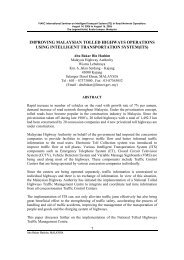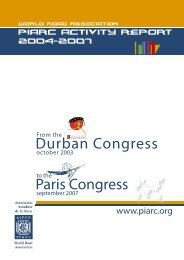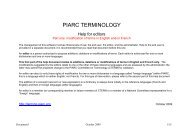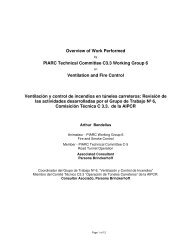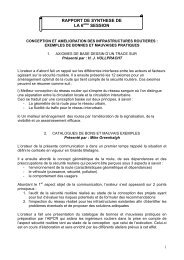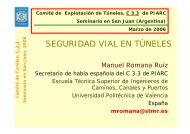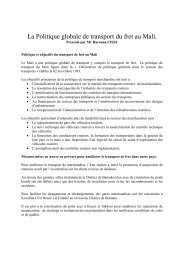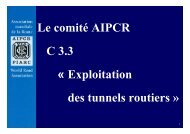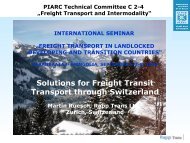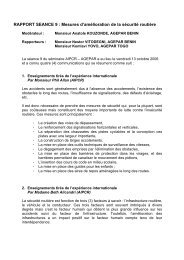General proceedings - Association mondiale de la Route
General proceedings - Association mondiale de la Route
General proceedings - Association mondiale de la Route
Create successful ePaper yourself
Turn your PDF publications into a flip-book with our unique Google optimized e-Paper software.
most of the techniques focus on <strong>de</strong>termining direct benefits that are easier to quantify and<br />
that there is an increasing trend to <strong>de</strong>termine the <strong>la</strong>rger impact of rural road investments on<br />
socio-economic <strong>de</strong>velopment and ultimately economic growth. Qualitative methods can be<br />
used for impact <strong>de</strong>termination.<br />
Highlights of the Presentation:<br />
• In the Southern Africa Development Community [SADC] region road transport carries<br />
over 80% of the region’s goods and services<br />
• It is estimated that about 1.8 million km of roads in Sub-Saharan Africa, of which only<br />
284,000km (approximately 16 %) are paved.<br />
• External investment in economic infrastructure 1 from 1990-1996 for Sub-Saharan Africa<br />
was US$26.7 billion, compared to US$41.4 billion for Latin America and the Caribbean<br />
and US$ 101.9 billion for Asia.<br />
• Parallel work indicated that a significant improvement in socio-economic living<br />
conditions was estimated with rural roads investment. The estimated benefits inclu<strong>de</strong>d the<br />
following: Improved accessibility to social infrastructure (schools and health centres),<br />
increased opportunities to access education and health facilities and improved social<br />
interaction and mobility, which are important for social and economic <strong>de</strong>velopment;<br />
improved access to markets by reducing transport costs; improvement of the<br />
marketability of perishable goods through timely and cheaper transport that will provi<strong>de</strong> a<br />
direct incentive for more market-oriented agriculture, with more profitable cash crops, an<br />
increase in rural income as well as additional employment opportunities.<br />
• Impacts of an investment on rural roads can be measured either directly (e.g. saving on<br />
VOCs, travel time), indirectly (e.g. jobs created) or induced (e.g. increased agricultural<br />
production).<br />
• Appraisal techniques such as Multi-Criteria Analysis (MCA) and Cost-Effective Analysis<br />
(CEA) are applied to support project appraisal of road investments through software tools<br />
such as HDM-4 and the RED mo<strong>de</strong>l.<br />
Session 4: Road Investment P<strong>la</strong>nning and its Management<br />
Title: IRF experience on road financing and investment worldwi<strong>de</strong><br />
Author & Presenter: Mr. Anthony Pearce (pictured), Director <strong>General</strong> International<br />
Road Fe<strong>de</strong>ration<br />
The presenter highlighted the international experience<br />
on PPPs, key steps for successful PPPs, both at a<br />
national level and at project level. He emphasized that it<br />
is important not to give the private sector the tough<br />
projects and keep the good ones for the public sector.<br />
He stressed also that easy projects and gradual private<br />
sector involvement will build success. In addition, he<br />
noted above all that it is crucial to have a firm public<br />
sector political commitment, with a focused, <strong>de</strong>dicated<br />
17



